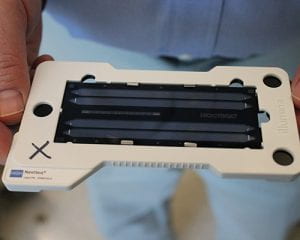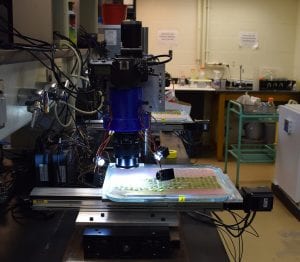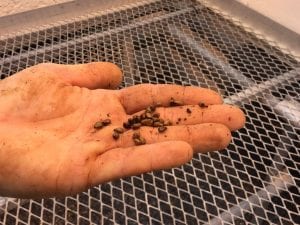Impacts
New Breeding Lines and Varieties under Development:
Low cost, highly transferable DNA marker platform developed:
 Researchers identified the core genome which encompasses the diverse Vitis genus.
Researchers identified the core genome which encompasses the diverse Vitis genus.- The core genome has been used to develop the rhAmpSeq marker panel which consists of more than 2,000 genomic sites that have been tested on 20,000 samples.
- Our team helped develop AmpSeq (or Amplicon Sequencing), a rapid and inexpensive method to identify new genetic markers.
- We are using AmpSeq to screen for fungicide resistance in commercial vineyards.
- rhAmpSeq, an even higher throughput method for marker identification, is now available for multiple crops and breeding programs.
- rhAmpSeq has been used to create genetic maps with 6 VitisGen families, totaling 3,069 samples from three different breeding populations.
Genetic mapping for marker assisted selection (MAS):
- Genetic maps have been developed for >20 core Vitis families.
- More than 70 marker-trait associations have been identified.
- Over 20,000 samples have been screened using Marker Assisted Selection (MAS).
- MAS eliminated over 60% of inferior seedlings (saving the breeding program significant time and money).
- 300 selected seedlings, based on previous years’ crosses, will begin fruiting in 2019.
Powdery mildew phenotyping robot:
- Through the development of computer vision and computer learning, we are able to quickly evaluate leaves for powdery mildew resistance.
- Currently, the powdery mildew (PM) robot is able to image a leaf disk on average every 20 seconds!
- So far, it has captured 219,702 images from 4,046 vines, accounting for 45TB of data.
- PM robot evaluates PM severity with 94% accuracy (as accurate as human experts)
- This project has designed and built 4 new laboratory production-grade imaging robots (called Blackbirds) for PM (and other diseases) screening, as well as an automated leaf disk punching and arraying robot.
- Learn more about PM phenotyping in this VitisGen webinar “Automated Evaluation of Grape Breeding Progeny to Reduce the Phenotyping Bottleneck“
Stacking powdery mildew resistance:
- In 2018, crosses were made from plants from Minnesota, New York and California that contain multiple genes for PM resistance. Over 600 seeds from these crosses are being grown out, in hopes of finding some with multiple genes coding for PM resistance (= more durable resistance).
- 550 of these seeds come from a parent that also has genes for foliar phylloxera resistance.
- In 2016, crosses were made to create a population with all possible combinations of four PM resistance genes. These are being placed into a repository for public use.
Wine quality trait marker validation:
- Over 2,000 samples are being phenotyped on nine populations, and will be analyzed to determine genetic markers tied to fruit quality traits.
Table grape cluster architecture marker validation:
 Two mapping populations have been planted.
Two mapping populations have been planted.- Clusters are being phenotyped for flowering time, veraison time, full color, ripening, cluster architecture, cluster density, cluster weight, juiciness, texture, berry size, berry shape, berry number, 10 berry weight, and more.
- DNA samples have been prepared and sent in for rhAmpSeq.
Annual Project Reports
Funding and Support
Funding for VitisGen2: Application of Next Generation Technologies to Accelerate Grapevine Cultivar Development is provided by a Specialty Crop Research Initiative Competitive Grant, Award No. 2017- 51181-26829, of the USDA National Institute of Food and Agriculture.
This project began September 1, 2017, and has been extended through August 31, 2022. The project is an extension of previous research developed under VitisGen: Accelerating Grape Cultivar Improvement via Phenotyping Centers and Next Generation Markers, which began in September 1, 2011 and ran through August 31, 2016.
The following research institutions are participants
in the VitisGen2 project:
- Cornell University
- Cornell Cooperative Extension
- USDA-ARS
- University of Minnesota
- South Dakota State University
- Missouri State University
- University of California, Davis
- Washington State University
- North Dakota State University
We would like to thank the members of the VitisGen2 Advisory Committee:
- Anne-Françoise Adam-Blondon, Unité de Recherche Génomique Info
- Terry Bacon, Sun World International
- Craig Bardwell, Welch’s
- Daniel Bosch, Constellation Brands
- Donnell Brown, National Grape Research Alliance
- Edward Buckler, USDA-ARS/Cornell University
- Peter Cousins, E&J Gallo Winery
- Nick Dokoozlian, E&J Gallo Winery
- Terrence Frett, Sun World International
- Franka Gabler, California Table Grape Commission
- Ksenija Gasic, Clemson University
- Dustin Hooper, Wonderful Nurseries
- Jerry Lohr, J.Lohr Vineyards & Wines
- John Martini, Martini Vineyards/Anthony Road Winery
- Esther Niu, Sun World International
- Dennis Rak, Double A Vineyards
- Tim Rinehart, USDA-ARS ONP
- Doreen Ware, USDA-ARS



